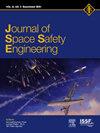轨道季节及其对太阳同步轨道近地卫星热电安全运行的长期影响
IF 1.7
Q3 ENGINEERING, AEROSPACE
引用次数: 0
摘要
与地球类似,近地轨道也存在轨道季节,了解这些季节影响对于确保航天器的长期性能和安全至关重要。然而,目前还缺乏确定轨道季节及其对电力供应系统的长期影响的方法。为了解决这一研究空白,我们提出了一种划分低地球太阳同步轨道全年轨道季节的方法。纳入了2021年至2023年四颗卫星的精确轨道数据,以确保实际相关性和通用性。结果表明,太阳同步轨道上的季节可分为4 ~ 10月的冷季和11 ~ 3月的热季。研究了卫星在不同轨道季节的热环境和供电系统性能。研究结果表明,应在炎热季节实施额外的热管理措施,以减轻系统故障风险,提高运行效率。该研究不仅是对以往轨道季节研究的补充,而且为未来航天器设计和管理提供了有价值的指导,强调了将热因素纳入任务规划的重要性,以确保安全有效的空间运行。本文章由计算机程序翻译,如有差异,请以英文原文为准。
Orbital season and its long-term effects on the thermal and electrical safe operation of low-Earth satellites in Sun-synchronous orbit
Similar to Earth, the orbital season also exists in a low-Earth orbit, and understanding these seasonal effects is crucial for ensuring the long-term performance and safety of spacecraft. However, methods for determining the orbital season and its long-term impact on the electricity supply systems are lacking. To address this research gap, we present a method for dividing the orbital season in the low-Earth Sun-synchronous orbit throughout the year. Accurate orbital data from four satellites from 2021 to 2023 were incorporated to ensure practical relevance and generalisability. The results indicate that the seasons in the Sun-synchronous orbit can be divided into a cold season, lasting from April to October, and a hot season, lasting from November to March. The thermal environment of satellites and the performance of the electricity supply system during different orbital seasons were studied. Our findings suggest that additional thermal management measures should be implemented during the hot season, which can mitigate system failure risks and enhance operational efficiency. This research not only complements previous studies on orbital seasons but also provides valuable guidance for future spacecraft design and management, emphasizing the importance of integrating thermal considerations into mission planning to ensure safe and effective space operations.
求助全文
通过发布文献求助,成功后即可免费获取论文全文。
去求助
来源期刊

Journal of Space Safety Engineering
Engineering-Safety, Risk, Reliability and Quality
CiteScore
2.50
自引率
0.00%
发文量
80
 求助内容:
求助内容: 应助结果提醒方式:
应助结果提醒方式:


